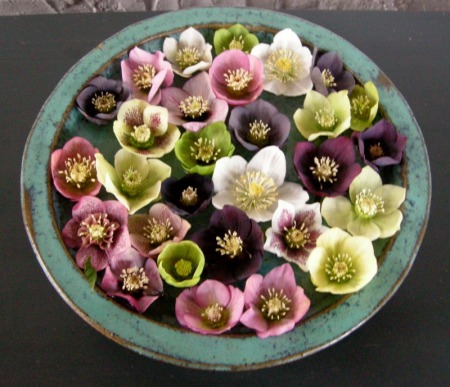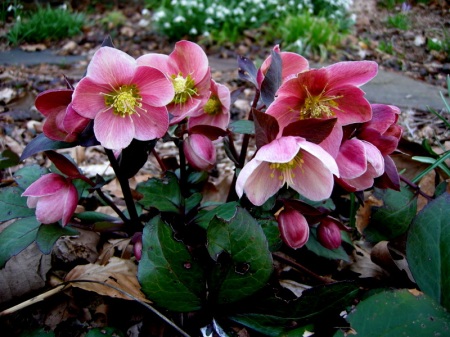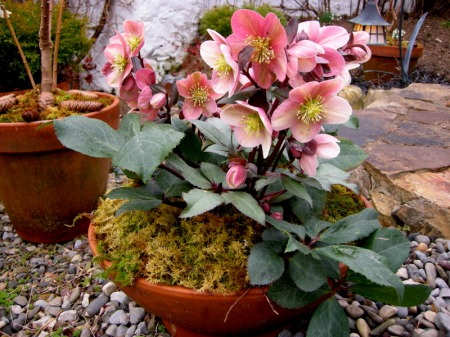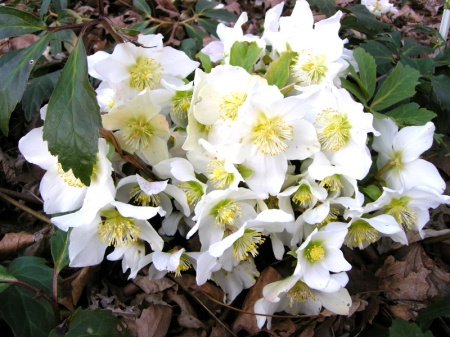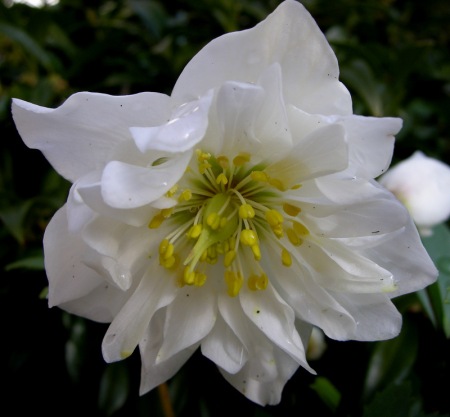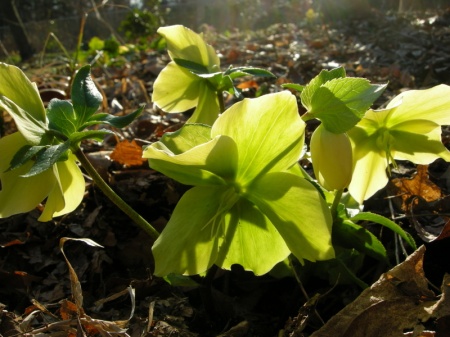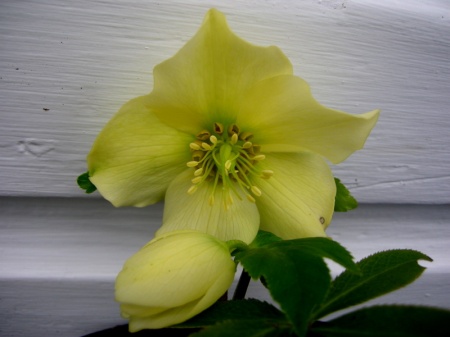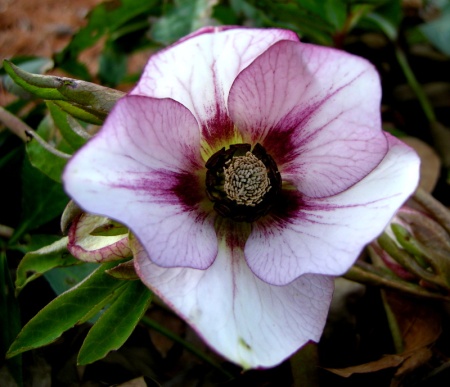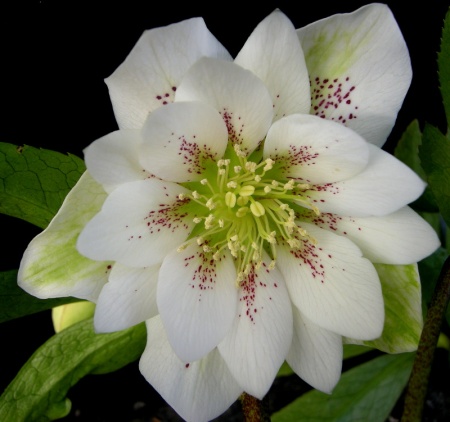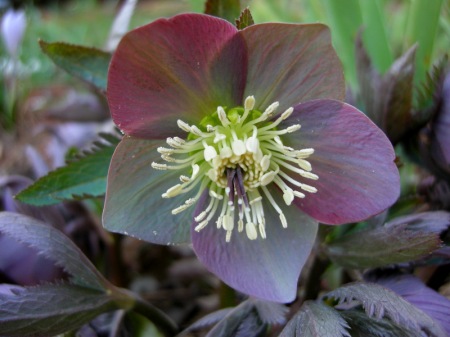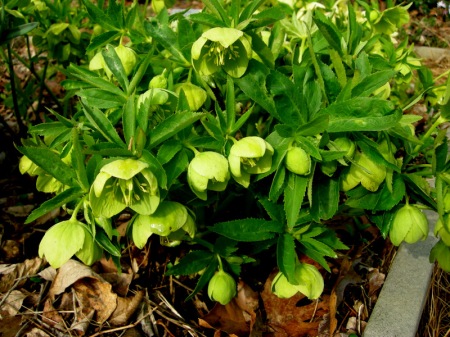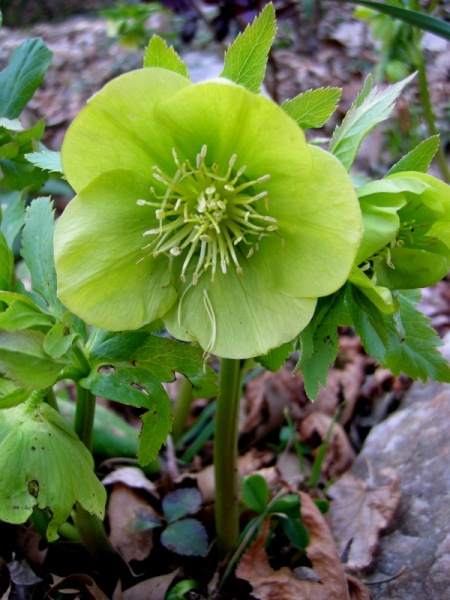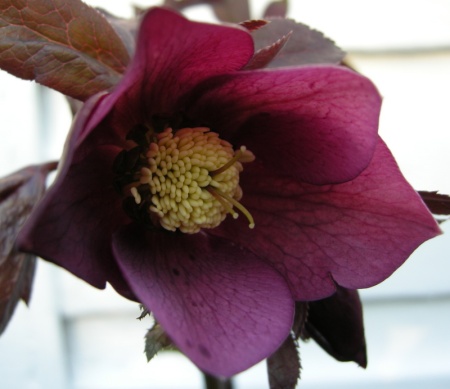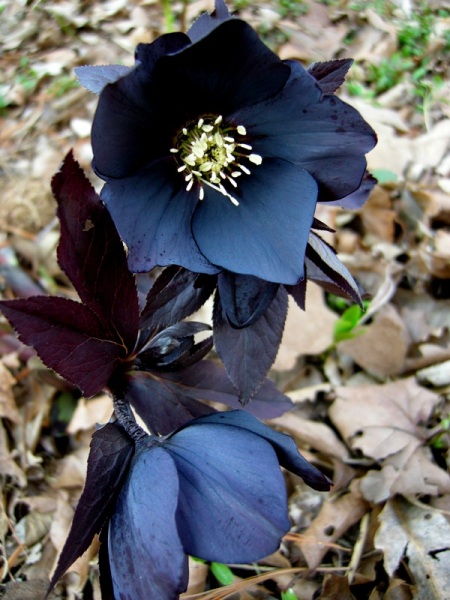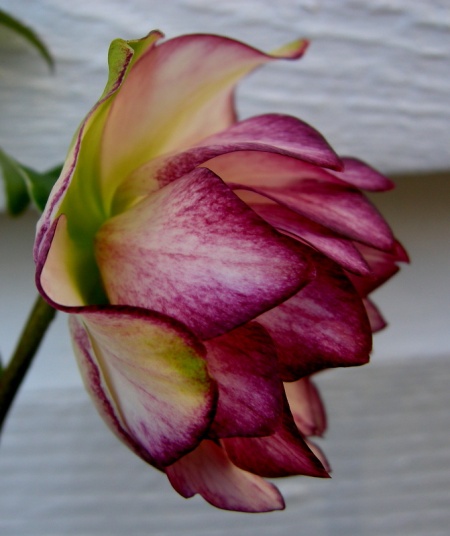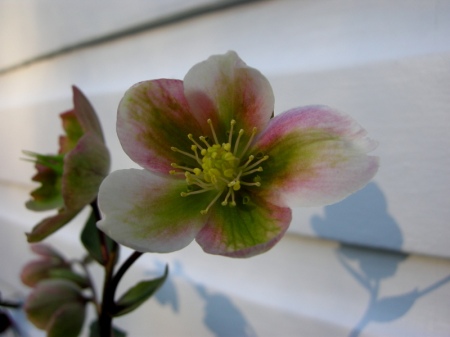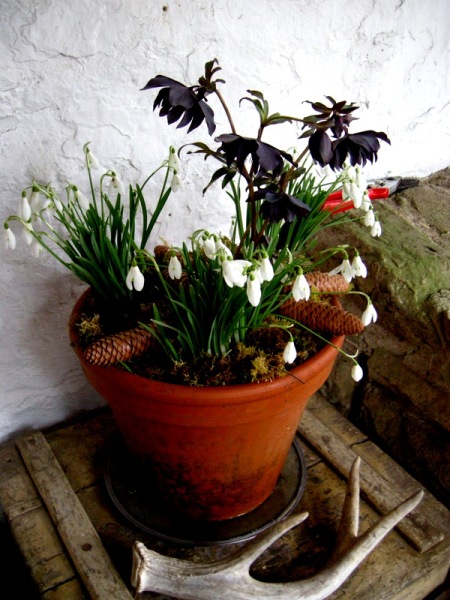Nursery News: Carolyn’s Shade Gardens is a retail nursery located in Bryn Mawr, PA, specializing in showy, colorful, and unusual plants for shade. The only plants that we ship are snowdrops and miniature hostas. For catalogues and announcements of events, please send your full name, location, and phone number (for back up use only) to carolyn@carolynsshadegardens.com. Click here to get to the home page of our website for catalogues and information about our nursery and to subscribe to our blog.
 A beautiful winter combination: snow crocus, white hybrid hellebore, and snowdrops in the background. This was one of the few hellebores that were up and open.
A beautiful winter combination: snow crocus, white hybrid hellebore, and snowdrops in the background. This was one of the few hellebores that were up and open.
What a winter! The snow is just melting and the ground is still frozen in places. Today it is 44 degrees and pouring rain. I don’t think the weather that we have had in March has reached the average highs for a normal February. All this has resulted in many problems for Carolyn’s Shade Gardens, and one of them was scheduling Charles Cresson’s 2014 Winter Interest Plant Seminars. Customers love these seminars during which Charles takes participants around his amazing Swarthmore garden and introduces them to the many plants that thrive in a winter garden.
.
 You can see from the preferred attire of seminar attendees that it was quite cold even on the rescheduled date of March 23.
You can see from the preferred attire of seminar attendees that it was quite cold even on the rescheduled date of March 23.
It became clear that we couldn’t hold the seminars on the “normal” dates of the third week in February as Charles’s garden was under several feet of snow. The “rain” dates in the first week of March were equally frozen. We opted for three weeks later, March 23, and 20 of the original 40 participants could actually come that day. Thanks so much to those 20 people who stuck with us through all the rescheduling.
.
 Charles gives the group background on his garden, Hedgleigh Spring. Plants for sale by Carolyn’s Shade Gardens are in the foreground.
Charles gives the group background on his garden, Hedgleigh Spring. Plants for sale by Carolyn’s Shade Gardens are in the foreground.
Although we probably saw less plants than we have in the previous three years, I think the group appreciated them more than ever before. Just the thought that spring might actually be coming was refreshing, and Charles’s enthusiasm for his plants was inspiring. For background on Hedgleigh Spring and Charles Cresson, see Winter Interest Plants 2011. For scenes from previous years, see Winter Interest Plants 2012 and Winter Interest Plants 2013.
.
 This technicolor crocus, C. sieberi ‘Tricolor’, caught everyone’s eye.
This technicolor crocus, C. sieberi ‘Tricolor’, caught everyone’s eye.
What follows are photos of some of the plants that we saw in the order we visited them. I hope that they will help everyone in the mid-Atlantic think spring.
.
 ‘Dawn’ viburnum, V. x bodnantense, is still tightly in bud though usually done blooming by now.
‘Dawn’ viburnum, V. x bodnantense, is still tightly in bud though usually done blooming by now.
.
 A close up of the rose-colored buds of ‘Dawn’ viburnum—-the flowers are a lighter pink.
A close up of the rose-colored buds of ‘Dawn’ viburnum—-the flowers are a lighter pink.
.
 The old-fashioned snowdrop ‘S. Arnott’ with ‘Rijnveld’s Early Sensation’, a February blooming daffodil.
The old-fashioned snowdrop ‘S. Arnott’ with ‘Rijnveld’s Early Sensation’, a February blooming daffodil.
.
 The buds of edgeworthia were not damaged by the cold and are just starting to swell while the hardy palm to the left looks great.
The buds of edgeworthia were not damaged by the cold and are just starting to swell while the hardy palm to the left looks great.
.
 The reticulate iris ‘J.S. Dijt’ was in full bloom while others were still to come.
The reticulate iris ‘J.S. Dijt’ was in full bloom while others were still to come.
.
 Japanese skimmia was only slightly damaged by our subzero temperatures.
Japanese skimmia was only slightly damaged by our subzero temperatures.
.
 Winter daphne looked a lot worse than the skimmia but will loose the brown leaves and grow fresh green ones before spring is over. The buds are fine and still to open.
Winter daphne looked a lot worse than the skimmia but will loose the brown leaves and grow fresh green ones before spring is over. The buds are fine and still to open.
.
 This tiny early daffodil with recurved petals, the species Narcissus cyclamineus, was much admired.
This tiny early daffodil with recurved petals, the species Narcissus cyclamineus, was much admired.
.
 Winter-blooming hardy cyclamen, C. coum, was also beautiful.
Winter-blooming hardy cyclamen, C. coum, was also beautiful.
.
 ‘Ballerina’, an elegant double snowdrop—it’s on my wish list.
‘Ballerina’, an elegant double snowdrop—it’s on my wish list.
.
.
 Dutch crocus, C. vernus, pushes through old sterbergia leaves.
Dutch crocus, C. vernus, pushes through old sterbergia leaves.
.
 ‘Bill Bishop’ snowdrop with its huge flowers and small stature.
‘Bill Bishop’ snowdrop with its huge flowers and small stature.
.
 Double winter aconite, Eranthis hyemalis, which Charles grew from seed.
Double winter aconite, Eranthis hyemalis, which Charles grew from seed.
.
 A very healthy clump of ‘Magnet’ hybrid snowdrop drooping from the cold.
A very healthy clump of ‘Magnet’ hybrid snowdrop drooping from the cold.
.
 Christmas rose, Helleborus niger
Christmas rose, Helleborus niger
.
 The rare species snowdrop Galanthus rizehensis.
The rare species snowdrop Galanthus rizehensis.
.
 The variety of spring snowflake with yellow markings, Leucojum vernum var. carpathicum.
The variety of spring snowflake with yellow markings, Leucojum vernum var. carpathicum.
.
 Another group of Leucojum vernum var. carpathicum.
Another group of Leucojum vernum var. carpathicum.
.
 Very rare semi-double spring snowflake ‘Gertrude Wister’, which originated in Swarthmore. Ten happy customers ordered one in my snowdrop catalogue.
Very rare semi-double spring snowflake ‘Gertrude Wister’, which originated in Swarthmore. Ten happy customers ordered one in my snowdrop catalogue.
.
 Common snowdrops and snow crocus, the essence of late winter in Charles’s meadow.
Common snowdrops and snow crocus, the essence of late winter in Charles’s meadow.
.
 The only sign of spring in the whole garden, longbract wakerobin, Trillium underwoodii, emerging.
The only sign of spring in the whole garden, longbract wakerobin, Trillium underwoodii, emerging.
The forecast going forward shows no nights below freezing and daytime temperatures in the 50s and even the 60s. Now I just have to get caught up somehow! It has been hard to find time to keep up with the blog and to read other blogs so I apologize to my readers and fellow bloggers.
Carolyn
Nursery Happenings: Our second sale is scheduled for the weekend of April 12, but the details are tentative. Customers on our list should look for an email or you can sign up for emails by sending your full name and phone number to carolynsshadegardens@verizon.net. Coming up after that is a shrub offer. If you have any shrubs you want, please email me at carolynsshadegardens@verizon.net
Carolyn’s Shade Gardens is a local retail nursery in Bryn Mawr, Pennsylvania, U.S., zone 7a. The only plants that we mail order are snowdrops and miniature hostas and only within the US.
If you are within visiting distance and would like to receive catalogues and information about customer events, please send your full name and phone number to carolynsshadegardens@verizon.net. Subscribing to my blog does not sign you up to receive this information.
Facebook: Carolyn’s Shade Gardens has a Facebook Page where I post single photos, garden tips, and other information that doesn’t fit into a blog post. You can look at my Facebook page here or click the Like button on my right sidebar here.
Notes: Every word that appears in orange on my blog is a link that you can click for more information. If you want to return to my blog’s homepage to access the sidebar information (catalogues, previous articles, etc.) or to subscribe to my blog, just click here.

